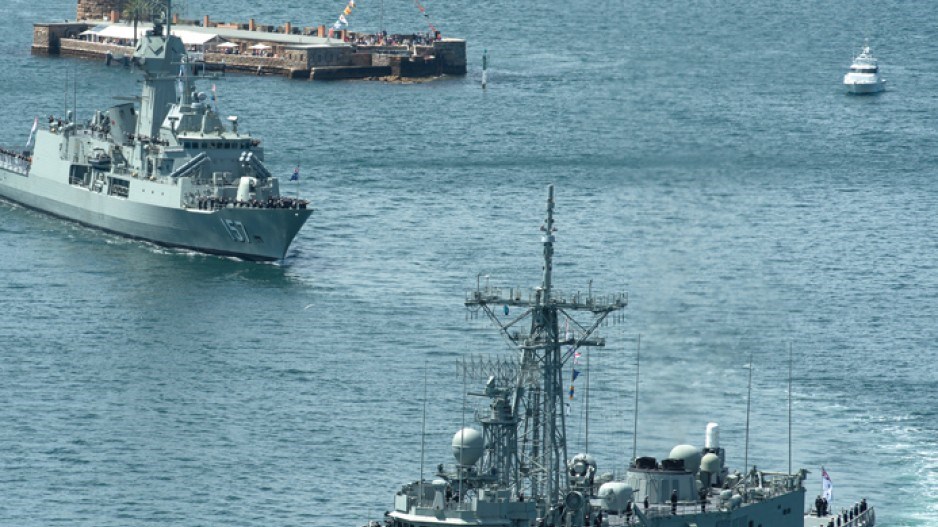Australia's defence minister, David Johnston, has aroused intense controversy in the midst of an $85 billion military re-equipment program by saying two of the biggest new naval ships will have to be built abroad because of delays and cost overruns in the domestic shipyards.
Johnston's outburst earlier this month over problems with an $8 billion project to build three state-of-the-art air warfare destroyers (AWD) came as conservative Prime Minister Tony Abbott prepared to set off for Ottawa and Washington. At a meeting with Barack Obama last week, Abbott and the U.S. president agreed to broaden and deepen Australia's expanding direct military relations with the United States.
Although there are many similarities between the histories and civic cultures of Australia and Canada, there have always been significant differences on defence policy and procurement. The fundamental difference is that Australians have always had to provide for the defence of their own territory, which faced the very real threat of invasion from Southeast Asia until relatively recently. Canadian governments, in contrast, have all too often taken a lazy approach to the protection of national sovereignty, figuring the U.S. will always fill any gaps in the wall of Canadian security.
Insecurity has also bred pragmatism in Australia. While there has always been a preference for locally manufactured defence equipment, there is little reluctance to buy abroad if that's a better deal.
Even the three powerful 6,500-tonne AWD warships, while being largely built in Australia, are based on a design by the highly successful Spanish company Navantia. The ships are being assembled from 31 prefabricated “blocks” supplied by several Australian companies and overseen by the Australian Submarine Corp. at Osborne in South Australia state.
But corporate restructuring in one of the subcontracting companies and faulty work in another – which meant that several “blocks” did not fit together – have caused mounting delays and costs.
This prompted Defence Minister Johnston to say that the next contract, for two new 20,000-tonne replenishment ships, will be chosen in a contest between Spain's Navantia and South Korea's Daewoo Shipbuilding and Marine Engineering. However, Johnston said that if Australia's shipbuilding industry can show by March next year that it has “got its act together,” the government will consider directing the next big project, for eight new frigates, at domestic companies.
Australia's program to modernize all three armed services, but primarily the navy, stems from a new defence white paper published in 2009 by the previous Labour Party government. But Australia's defence procurement policies, unlike Canada's, usually survive changes of government. The new policy, which is predicated on China becoming increasingly dominant in Asia, reflects Australia's intention to strengthen its U.S. alliance, while maintaining its own defence and support for regional allies.
A key component of Australia's new military doctrine is the ability to deploy expeditionary forces to other parts of Asia to support allies. To that end, two new 27,000-tonne ships are on “shakedown cruises” ahead of being delivered to the navy by the manufacturers.
Called euphemistically “landing helicopter dock” ships, each capable of transporting up to 110 military vehicles and 1,600 troops, these look to the casual observer very much like aircraft carriers.
While their air arm will be primarily helicopters, each of the $1.5 billion ships has a “ski jump” on the bow, allowing short takeoff and landing of fighter-bombers such as Harrier jumpjets to use the carriers if required.
Meanwhile, Johnston and Foreign Minister Julie Bishop were in Japan a week ago. Australia is considering replacing its unreliable fleet of six Collins-class submarines with 12 of Japan's Soryu-class diesel electric submarines, considered by many experts to be the best in the world. •
Canada snubbed Oz offer to jointly build submarine force
In the late 1970s the Australian and Canadian defence departments recognized that their post-Second World War British Oberon-class submarines needed replacement.
The Australians figured that this coincidence provided an opportunity for the sister nations to co-operate in building new boats. The Canberra department sent a letter to its Ottawa counterpart suggesting a joint venture to build vessels for their own submarine fleets and create a new industry selling boats to third parties.
This ambitious vision got nowhere in Ottawa where, as usual, the priority was to try to get another decade of use out of the “O”-class submarines. Having been not so much rebuffed as ignored by Ottawa, the Australians developed the Collins-class boats, based on a design by the Swedish shipbuilder Kokums.
Six of the Collins submarines have been in service since 1990, but they have been plagued by design and technical problems. It can only be speculated whether a joint venture with Canada would have avoided or overcome these difficulties.
Ottawa went on in the 1980s to toy with buying either British or French nuclear-powered submarines. But Washington leaned on Ottawa to buy conventional diesel-electric boats. With no diesel-electric submarines of its own, the United States Navy wanted Canada to have conventional boats so it could hone its own anti-submarine warfare skills.
Ottawa complied. In 1998 it bought four mothballed British Upholder-class submarines for $750 million. But the program has been a fiasco, costing billions of dollars to refit the submarines. All four have been technically unreliable and plagued by accidents.




